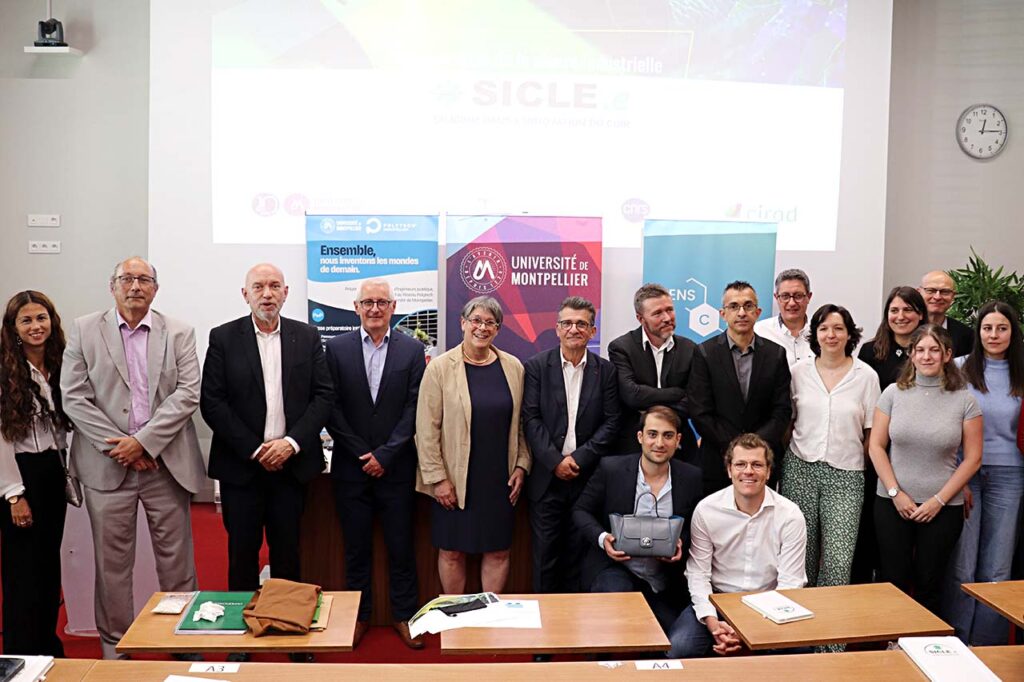Leather industry: a new chair to promote revolutionary, virtuous tanning
The University of Montpellier has inaugurated the SICLE.e industrial chair, focusing on an innovative silicon-based leather tanning process. This is one of the first projects in the Occitanie region to receive funding under the French National Research Agency's call for Industrial Chairs.National Research Agency (ANR). Spotted during a webinar to raise awareness of the "Joint Laboratories" organized as part of Montpellier's Pôle Universitaire d'Innovation (PUI), the project was subsequently supported by the university's Innovation and Partnerships Department (DIPA).

Although it was he who submitted the project to the ANR, Gilles Subra insists that this new chair is the fruit of an eminently "collective" effort. Inaugurated on Tuesday May 20 at the University of Montpellier in the presence of President Philippe Augé, the SICLE.e Chair brings together a number of partners: the CTC Group, theMax Mousseron Institute of Biomolecules (IBMM), theCharles Gerhardt Institute of Montpellier (ICGM), and CIRAD's BioWooEB laboratory. Their aim: to promote a more virtuous leather industry by developing new technologies based on the use of silicon.
The story begins in 2021. At the time, in the secrecy of their laboratories, Ahmad Mehdi's team at ICGM and Gilles Subra's at IBMM had already been working for several years on combining silicon and collagen, "in the context of health and regenerative medicine issues", confides Gilles Subra, a researcher at IBMM. So when a doctoral student in his team learned that the Centre Technique du Cuir (CTC) group was looking for partners to find innovative tanning solutions, he and his colleagues took up the challenge. "As collagen is the main constituent of leather, we quickly realized that the techniques we were using for regenerative medicine could be used to tan skin", he explains.
"Game changer
In the process, the researchers and the CTC group agreed on three research contracts to kick-start the collaboration, followed by two patents in 2024, before jointly submitting this industrial chair project to the ANR that same year. "There were so many development possibilities that it was impossible to continue with piecemeal contracts. We had to give ourselves more time to explore new technologies and give the projects a chance to come to fruition; the chair was the perfect solution". All in all, a lasting cooperation, and some very promising avenues of research. "The prerequisites imposed by the ANR included a disruptive innovation, a "game changer", and that it should be of interest to an entire economic sector, not just one company. A Chair implies an impact on an entire value chain," explains Gilles Subra. Having ticked all these boxes, in June 2024, the team was the very first winner of the ANR Industrial Chairs call for projects in the Occitanie region.
In concrete terms, it is developing a genuine alternative to chrome tanning, which until now has produced the highest-quality results, despite its potential impact on the environment. Unlike the metals used in most cases, silicon is an inexhaustible, non-toxic resource. "The heart of our innovation is that silicic acid is capable of polymerizing when it enters the skin, and creating networks between collagen chains. This is what transforms skin into leather, giving it rot-proof qualities", explains Gilles Subra.
Two patents
Unlike traditional tanning, which produces a bluish skin, silicon tanning develops white leathers. "This makes it possible to imagine pastel shades that were previously unobtainable". Last but not least, this process produces no toxic waste. Last but not least, the silica chains that freeze the tanning process are capable of forming durable bonds with molecules of various properties, and "functionalizing" the leather in a lasting way. In short, it is possible to create antifungal leather via a molecule capable of spreading throughout the silica network, as well as water-repellent, fluorescent or even "anti-counterfeiting" leather by inserting an invisible marking capable of revealing itself when exposed to certain lights... A revolutionary aspect which was the subject of the team's second patent, following the first patent on the tanning process itself.
While the team was already working on these technologies before the creation of the Chair, the University of Montpellier's Innovation and Partnerships Department (DIPA) was involved in putting together the application to the ANR. " DIPA was on hand to help us draw up the application, calculate the budget and give us tips on how best to present our research," adds Gilles Subra.
Convincing luxury professionals
From now on, the team hopes to move upmarket. "We know that our technology can already be implemented in tanneries. Several of them are already using our process to train their employees. But we want to achieve a quality equivalent to that of chrome tanning in terms of suppleness, appearance, and feel, according to the highest leather goods standards. The luxury goods industry is our biggest customer; if we can convince them, the whole industry will follow". The researchers also hope to improve the packaging and shelf life of silicic acid, which is currently only stable for two weeks in cans. Finally, they will continue to exploit leather scraps and the thousand possibilities for waste recovery: removing the silicon to compost the leftovers, using the skin to make gelatin for the animal feed industry, designing new composite materials based on unused scraps, or transforming waste into biochar, the coals used in agriculture to capture water in arid soils and regulate pH...
The entire team includes a full-time researcher, two PhD students over the four-year period, and 12 Masters students on a six-month research internship each. Not forgetting the staff of the associated laboratories, and the eight people in the CTC group dedicated to the project, which has a total budget of 4.5 million euros, including 1.04 million specifically earmarked for the industrial chair as part of the call for projects. "If we make fast enough progress, we hope to see our first articles for the general public as early as next year".